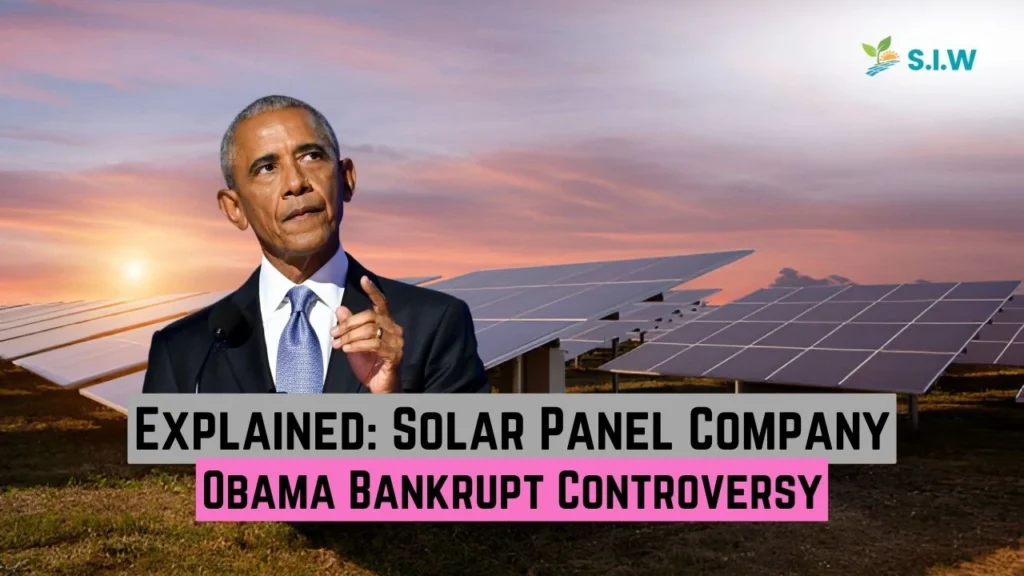The Solar Panel Industry’s Growth and Challenges
The solar industry has witnessed rapid expansion as global demand for sustainable energy solutions rises. Solar panel companies have been at the center of this shift, with governments worldwide investing in renewable energy for long-term environmental benefits. However, not all ventures succeed, leading to significant scrutiny. One of the most discussed cases is the Obama administration’s involvement in financially supporting solar companies, some of which later filed for bankruptcy. This controversy has fueled debate about the risks of green energy investments and government-backed funding.
Understanding the Obama-Era Solar Panel Funding and Bankruptcy Scandals
The Obama administration’s commitment to green energy was backed by substantial financial incentives aimed at fostering a shift toward renewable resources. As part of the 2009 American Recovery and Reinvestment Act (ARRA), the administration allocated over $90 billion to renewable energy projects, which included extensive funding for solar panel companies. The aim was to reduce fossil fuel dependency, create jobs, and lead the charge toward a cleaner energy future.
Key Solar Companies Involved in the Controversy
During this period, several companies received federal loans, with some eventually filing for bankruptcy. The following companies became central to the controversy due to their high-profile failures:
- Solyndra: Received $535 million from the U.S. Department of Energy (DOE) but filed for bankruptcy in 2011.
- Abound Solar: Obtained $400 million in federal loans, yet failed in 2012.
- Beacon Power: Secured $43 million and declared bankruptcy within a year.
These cases raised concerns about the effectiveness of the loan program and whether the taxpayer-funded investments were appropriately managed.
The Fallout of the Solyndra Bankruptcy
The collapse of Solyndra, often cited as a pivotal moment in the Obama-era solar funding controversy, highlighted the challenges of government-backed renewable energy initiatives. Despite substantial funding aimed at promoting American solar technology, Solyndra struggled to compete against cheaper solar panels from international manufacturers, especially those based in China. Ultimately, the company’s bankruptcy cost taxpayers millions and became a focal point of political debate regarding government intervention in private enterprise and the viability of large-scale investment in emerging industries. This case also prompted greater scrutiny of the best commercial solar companies, pushing for both innovation and cost-effectiveness to compete on a global scale.
Factors Contributing to the Failure of Solar Panel Companies
Several factors contributed to these failures, with the common issues ranging from market conditions to strategic mismanagement. Understanding these factors highlights the complex challenges solar companies face, even with government support.
1. Global Competition and Price Volatility
The market for solar panels has been highly competitive, with price wars fueled by international manufacturers. Chinese solar panel companies, supported by government subsidies, flooded the market with low-cost products, which companies like Solyndra struggled to match.
2. Technological and Operational Misalignment
Many funded companies pursued unique technologies that proved too costly or complex for large-scale production. In the case of Solyndra, its cylindrical solar panels were innovative but ultimately inefficient and expensive compared to traditional flat panels.
3. Lack of Adaptability to Market Demands
The renewable energy industry is marked by rapid technological advancements, with consumer demands constantly evolving. Failure to pivot toward cost-effective production models resulted in mounting financial losses.
The Broader Implications of the Solar Panel Bankruptcy Scandals
The controversy surrounding these bankruptcies has led to increased scrutiny over government involvement in funding private sector projects, particularly in emerging industries like renewable energy. The outcome highlighted several broader implications:
- Increased Due Diligence on Federal Funding: Since these incidents, government programs have emphasized stricter evaluation and oversight for companies seeking federal loans.
- Public Skepticism of Green Energy Investments: High-profile failures have led some to question the viability of renewable energy projects and the role of taxpayer dollars in supporting them.
- Impact on Future Renewable Energy Policies: The controversy influenced subsequent administrations’ approaches to funding renewable projects, with a shift toward risk reduction and more stringent accountability.
Lessons Learned and the Path Forward for Solar Energy
Despite the controversies, the growth of solar technology remains a priority globally. The incidents of company failures emphasize the need for innovation, strategic planning, and sustainable pricing strategies to ensure that investments yield long-term benefits. Current trends in solar energy focus on collaboration between the private sector and government with clear, accountable practices that maximize both fiscal responsibility and environmental impact.
FAQs
- Why did solar panel companies supported by the Obama administration go bankrupt?
Many factors contributed, including intense global competition, high production costs, and operational inefficiencies. Market conditions also favored cheaper international products, making it difficult for these companies to stay competitive. - How much did Solyndra’s bankruptcy cost taxpayers?
Solyndra’s bankruptcy resulted in the loss of approximately $535 million in taxpayer funds. - Did these bankruptcies impact future government funding for renewable energy?
Yes, the bankruptcies led to increased scrutiny and due diligence for future government-backed renewable projects, with a stronger focus on accountability. - Has the U.S. government changed its approach to funding green energy?
Since the Obama administration, subsequent administrations have implemented stricter evaluation criteria for federal loans to renewable companies to mitigate similar risks. - What are the current challenges for solar companies?
Today’s challenges include market saturation, price competition, technological advancements, and the need for sustainable cost management to remain competitive.








